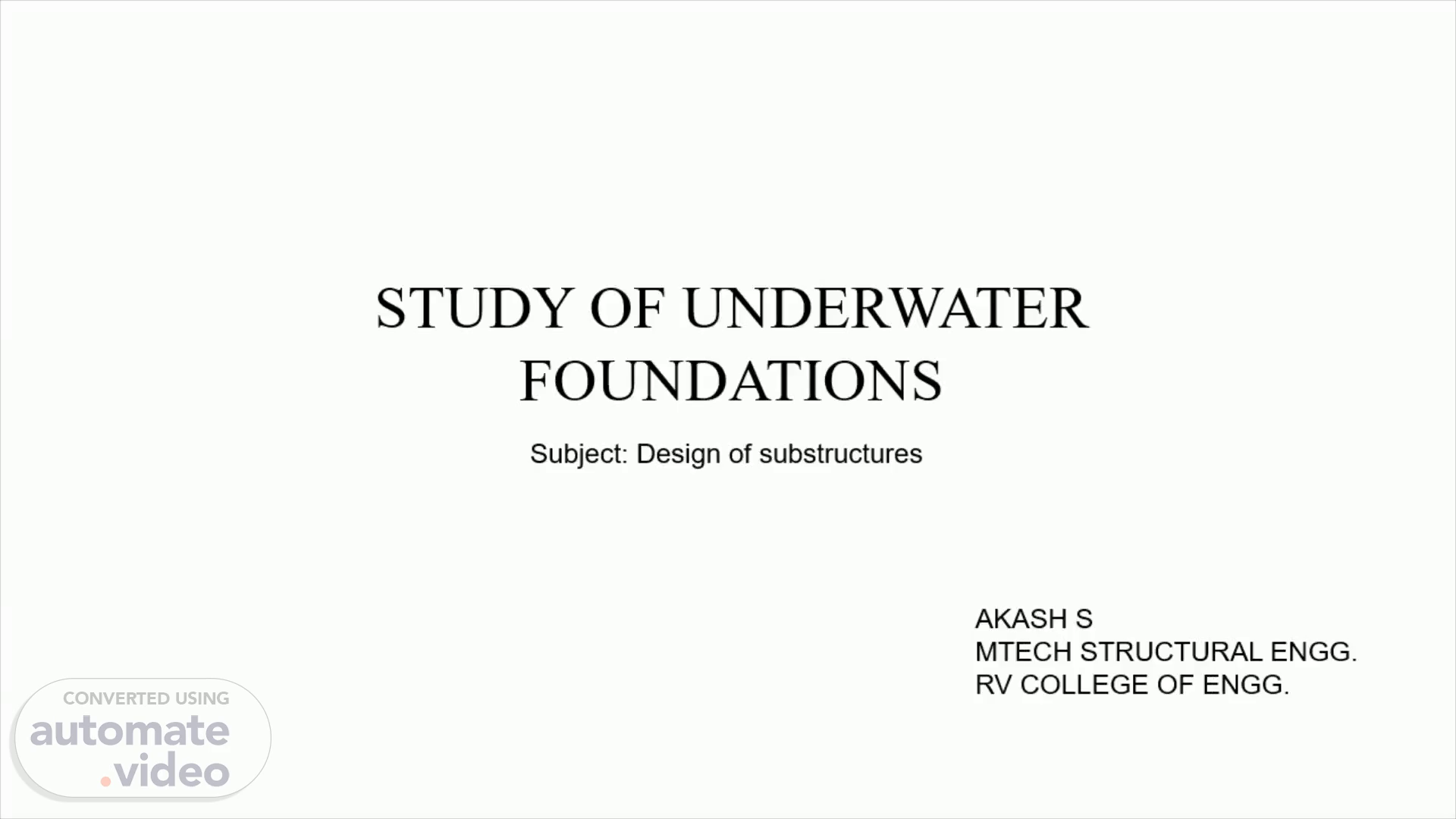
Page 1 (0s)
STUDY OF UNDERWATER FOUNDATIONS. Subject: Design of substructures.
Page 2 (9s)
Objectives. The purpose of this report is to provide an overview of underwater geotechnical foundation design and construction and preliminary guidance based on past and current technology applications. Underwater foundation selection and design choices have generally been based on foundation construction in the dry , that is, within a pre-installed cofferdam that isolates the construction from the surrounding body of water, or on dry land with water diversion Dry land method may not be an option unless the body of water can be feasibly diverted. Cofferdam design and construction efforts require additional time and expense to be budgeted for project completion. ..
Page 3 (36s)
Site and Foundation Selection Process. Site investigations are an essential part of the underwater site selection, foundation design, and foundation installation elements. Site conditions - topography, bottom current, sediment loading and scour, and other environmental conditions Engineering properties - soil/rock lithology and stratigraphy, strength, durability, compressibility, and seismic concerns must be explored and characterized prior to foundation final selection and design. Following assesment are to be done: Site assessment: Geologic, topographic, and geographic influences are important within the given projects political boundary and should be studied extensively during the site selection process..
Page 4 (1m 3s)
Soil and rock engineering properties: A subsurface investigation is vitally important in the foundation selection and design process since it helps the designer understand the soil/rock response to the imposed structural loads. Structure function: The structures intended function must be properly identified. Two aspects of the structures foundation function that must be addressed are its intended design life and its factor of safety. Installation requirements: Inherent in the foundation selection and design process are the questions of installation equipment and labor, procedures, and quality control. Contract cost: Balancing the requirement for a reasonable degree of confidence in the foundations utility with the goal of achieving the lowest project cost is another important variable in the foundation selection process..
Page 5 (1m 35s)
Foundation Selection Criteria and Design Issues. The foundation must be selected, designed, and constructed to achieve acceptable performance during its anticipated lifetime. Selection and design criteria for onshore (land-based) foundations are listed in numerous publications, but published criteria for selection and design of underwater foundations are, in general, somewhat limited. Although the offshore industry has published guidelines for foundation design, installation, behavior, and testing, the selection guidelines covering all possible types of underwater foundations are not commonly found in the literature. As foundation costs increase and different foundation types become more available to designers and constructors,then greater emphasis will be placed on selecting the best foundation for a particular application..
Page 6 (2m 5s)
Foundation Types. 1.Pinned foundations Pinned foundation embedment depths are greater than the minimum lateral dimension , and include piles and drilled shafts. They are installed to achieve greater lateral stability , to provide greater uplift resistance , to provide greater resistance to scouring compared with gravity-based foundations, and to minimize the potential for differential settlement of certain critical structures. Pinned foundations are constructed of wood, steel, concrete, grout, stones, or polymer materials that are pinned into the seabed or river bottom by application of driven or drilled-energy sources..
Page 7 (2m 33s)
2.Gravity-based foundations. Gravity-based foundations are broadly classified because the load-carrying capacity is primarily determined by the size and weight. These foundations are similar in function and design to the land-based foundations that are classified as shallow; since their embedment depths are generally less than their lateral dimensions. Figure illustrates usage of man-made bridging mats and geotextiles combined with dredging excavation and vibratory compaction..
Page 8 (2m 56s)
Typical gravity foundations are constructed of precast concrete elements . The foundation is designed to resist the imposed compression, tension, overturning, lateral, and dynamic forces..
Page 9 (3m 9s)
Conclusion. In conclusion, underwater foundations constructed in the wet may allow an alternative to expensive in-the-dry cofferdam construction. Underwater foundations have been used extensively offshore, since in-the-dry installations are not an option in deeper water. This report provides a general overview and description of geotechnical foundations constructed in the wet (underwater) Developing more experience regarding design and construction of in-the wet foundations (especially for navigation and flood control structures on inland waterways). The innovative in-the-wet construction approach may offer a significantly beneficial alternative to typical in-the-dry construction..